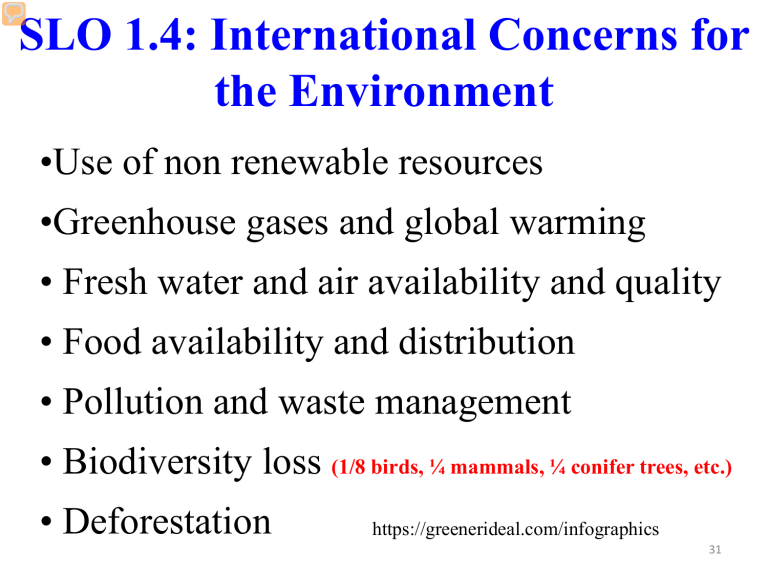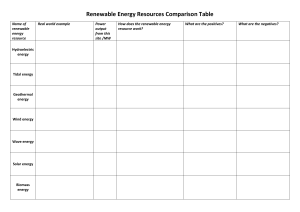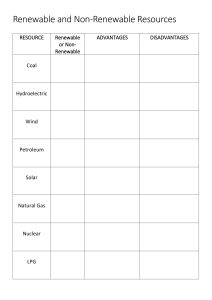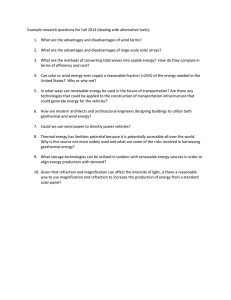
SLO 1.4: International Concerns for the Environment •Use of non renewable resources •Greenhouse gases and global warming • Fresh water and air availability and quality • Food availability and distribution • Pollution and waste management • Biodiversity loss (1/8 birds, ¼ mammals, ¼ conifer trees, etc.) • Deforestation https://greenerideal.com/infographics 31 Can Conventions Do all the Work? • The Kyoto Protocol to the United Nations Framework Convention on Climate Change (UNFCCC) sets binding obligations on industrialized countries to reduce emissions of GHG. (Some are cooperating within the Kyoto Protocol.) • COP 21: Conference of the Parties, referring to the countries that have signed up to the 1992 United Nations Framework Convention on Climate Change. The COP in Paris is the 21st such conference. • COP21 is aiming to achieve a legally binding and universal agreement on climate change, with the aim of keeping GW well below 2°C. • How to promote energy efficiency? – Standards, labeling, and barrier removal – Private-public partnerships – Gov. procurement and market transformation activities on a regional basis. 32 What are the Kyoto Protocol (KP) and the COP21? • The KP, an agreement negotiated • COP21 was the 21st by many countries in Dec. 1997 “Conference of the Parties” – and came into force with Russia's an annual UN conference on ratification on Feb. 16, 2005. the subject of the climate and climate change. The 2016 COP meeting was held in Paris from • The KP was developed under the 30th Nov. to 11th Dec. the UNFCCC - the United Nations Framework Convention on Climate Change. • It brought leaders with the aim of achieving a legally binding and universal agreement on the • KP sought to see participants climate. The aim is to keep collectively reduce GHG global warming below 2°C. emissions by 5.2% below the 33 emission levels of 1990 by 2012. Recommendations for Effective Climate Protection The only thing that could help keep climatic effects at a manageable level would be a reduction in GHG emissions. By 2050 GHG emissions worldwide would have to be reduced to half of what they were in 1990. The industrialized countries are currently causing the biggest per head output of greenhouse gases. The developing and emerging countries justifiably want to catch up in terms of prosperity and energy demand. Therefore, the industrialized countries have to make the biggest contribution towards reducing GHG emissions. Recommendations for Effective Climate Protection (Cont.) Based on decisions made in 1990, the following targets have been set as a minimum goal for industrialized countries: Reduction in GHG emissions of 25 to 30% by 2005 Reduction in GHG emissions of 40 to 50% by 2020 Reduction in GHG emissions of 80% by 2050 Reduction in GHG emissions of 90% by 2100 35 SLO 1.5: Characteristics of renewable energy sources • Flows of energy that are regenerative or virtually inexhaustible at a human scale. • Most commonly includes solar (PV and thermal), biomass, geothermal, wind, tidal, wave, and hydro power sources, etc. 36 Renewable Energy (Solar facts) Each year the sun radiates 1.5 quintillion kilowatt hours of energy towards the earth. The atmosphere swallows up around 30% of this energy but over one quintillion kilowatt hours are still able to reach the earth’s surface. Our current primary energy needs are around 125 trillion kilowatt hours worldwide. A quintillion is a 1 with 18 zeros, and a trillion has 12 zeros. Thus, the amount of energy that reaches the earth’s surface each year is 8000 times > the total primary energy requirement of the world. So, we only need to use about 1 hour’s worth of the solar energy that reaches the earth’s surface in order to cover the energy needs of the whole of mankind for a whole year. Equation: 1h Solar Energy = 1year humans' energy needs. 37 Renewable Energy (Comparative facts) Annual renewable energy available and global primary energy 38 requirement with the total existing conventional energy sources on Earth. Sources, Conversions, and Utilizations of Renewables 39 Advantages of Renewable Energy • They are inexhaustible at a human scale – they will always be available – they are renewable • They are clean and will not damage the Earth • There are several types – so one or more of them is present in each country • Most natural sources can be used on a small scale and serve local needs, thus cutting costs of transmitting the energy 40 Advantages of Renewable Energy (Cont.) • • • • • • • • Huge amount of energy available, A 5 billion year lifetime, Drastically cleaner than non-renewables, Widely distributed around the planet, Many technologies available and affordable, R&D providing even more options, Decentralized technology-more jobs and security, Non-renewable energy is rapidly depleting, and is destroying the planet. 41 “New” Renewable Energy Sources “New” renewables are a group of alternative energy sources that include Energy from the Sun, wind, geothermal heat, and movement of the ocean water. They are commonly referred to as “new” because: They are not yet used on a wide scale; Their technologies are still in a rapid phase of development; and They will play a much larger role in the future energy mix. 42 • Solar Energy Solar energy is created from sunlight, or heat from the sun radiation. Solar is captured when energy from the sun is converted into electricity; used to heat air, water, or other fluids. There are currently two types of S.E Technologies: • Solar thermal: these systems convert sunlight into thermal energy (heat). Most solar thermal systems use solar energy for space heating or to heat water (such as in a solar hot water system). • This can be used to drive a refrigeration cycle, or to generate steam to run a steam turbine. • Solar photovoltaic (PV): the conversion of sunlight directly into electricity using photovoltaic cells. • PV systems can be installed on rooftops, integrated into building designs, and vehicles, or scaled up to megawatt scale power plants. 43 • Wind Energy Wind energy is generated by converting wind currents into other forms of energy using wind turbines. Winds are generated by complex mechanisms involving the rotation of the Earth, the heat capacity of the sun, the cooling effect of the oceans and polar ice caps, temperature gradients between land and sea, and the physical effects of mountains and other obstacles. • Wave or Tidal Energy Wave power generates electricity using special buoys that use the rising and falling of ocean waves to generate electricity. Tidal power generates electricity using underwater turbines designed to capture the kinetic motion of ebbing and surging ocean tides. 44 • Hydroelectric Power (HP) • Hydropower is often referred to as water power. The simplest definition of hydropower would be the power that derives from the force of energy of the moving water. • Hydropower doesn't only refer to large hydroelectric power plants, it also includes small and micro hydro systems. • HP is currently the most common form of renewable energy and plays an important part in global power generation. Worldwide HP produced 3 288 TWh, just over 16% of global electricity production in 2008, and the overall potential for HP is estimated to be more than 45 16 400 TWh/yr. https://www.iea.org • Geothermal Energy (GE) • Geothermal is the heat from the Earth. It is clean and sustainable. • Resources of Geothermal range from shallow ground to hot water and hot rock found a few miles beneath earth’s surface. • Also found down even deeper to the extremely high temperatures of molten rock called Magma. 46 • Biomass Energy • Biomass power is carbon neutral electricity generated from renewable organic waste that would otherwise be dumped in landfills, openly burned, or left as fodder for forest fires. • When burned, the energy in biomass is released as heat. • If you have a fireplace, you already are participating in the use of biomass as the wood you burn in it is a biomass fuel. 47 Biomass Energy Cycle • Carbon neutral – CO2 ultimately released in energy generation is recently captured and so ideally does not change total atmospheric levels – Carbon leaks can result in a net increase in CO2 levels 48 Characteristics of Renewables (Summary) The resources which can be renewed along with their exploitation and can be always available for use are known as renewable sources. Some of the main characteristics of renewable resources are: These resources are capable of regeneration. These are renewed along with exploitation. Thus, always available. The regeneration of these sources involves some ecological processes on a time scale. The renewable sources become nonrenewable if used at a greater rate than the environment’s capacity to replenish them. These resources comprise materials like food, timber, raw materials for clothing’s, leather, etc. These also include oxygen, fresh water, solar energy, and biomass. Renewables’ Growth (fast) They are growing at much faster rates than conventional sources: Solar and Wind power are the fastest growing RE However, since these sources began at low levels, it will take time to build them up. Growth rates 2005-2035: Solar 8.3% per year, Wind 5.7% /year Geothermal 3.7%/year Hydropower 2.0%/year Other renewables 1.4%/yr. (Such as Wood waste, landfill gas, agricultural byproducts, etc.) 50 SLO 1.6: Appropriate renewable sources for the UAE • Solar energy is the most available renewable source in UAE. • Solar based systems: Both solar thermal and solar PV technologies are good candidates for the UAE. • In some parts of UAE, Wind energy is available. Give some examples:…………………………………… • Geothermal energy is also available in few places 51 52





